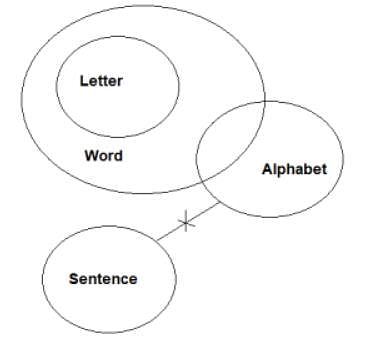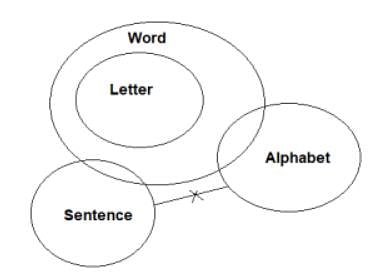CLAT Exam > CLAT Questions > In the question below there are three stateme...
Start Learning for Free
In the question below there are three statements followed by three conclusions I, II and III. You have to take the three given statements to be true even if they seem to be at variance from commonly known facts and then decide which of the given conclusions logically follows from the three statements disregarding commonly known facts.
Statements:
Only words are letters.
Mostly alphabets are words.
No sentence is alphabet.
Conclusions:
I. Some words are letters.
II. Some words are sentences.
III. Some letters are alphabets.
- a)Both conclusion I and conclusion II follow.
- b)Only conclusion I follows
- c)Neither conclusion I nor conclusion II follows
- d)Only conclusion II follows
- e)All conclusions I, II and III follow
Correct answer is option 'B'. Can you explain this answer?
Verified Answer
In the question below there are three statements followed by three con...
Following figure can be formed:


From the figure, only conclusion I follows.


From the figure, only conclusion I follows.
Hence, option b.
 This question is part of UPSC exam. View all CLAT courses
This question is part of UPSC exam. View all CLAT courses
Most Upvoted Answer
In the question below there are three statements followed by three con...
Statements:
- Only words are letters.
- Mostly alphabets are words.
- No sentence is alphabet.
Conclusion I: Some words are letters.
This conclusion follows from the given statements as the first statement states that only words are letters, implying that words are a subset of letters.
Therefore, Conclusion I follows.
- Only words are letters.
- Mostly alphabets are words.
- No sentence is alphabet.
Conclusion I: Some words are letters.
This conclusion follows from the given statements as the first statement states that only words are letters, implying that words are a subset of letters.
Therefore, Conclusion I follows.

|
Explore Courses for CLAT exam
|

|
Similar CLAT Doubts
In the question below there are three statements followed by three conclusions I, II and III. You have to take the three given statements to be true even if they seem to be at variance from commonly known facts and then decide which of the given conclusions logically follows from the three statements disregarding commonly known facts.Statements:Only words are letters.Mostly alphabets are words.No sentence is alphabet.Conclusions:I. Some words are letters.II. Some words are sentences.III. Some letters are alphabets. a)Both conclusion I and conclusion II follow.b)Only conclusion I followsc)Neither conclusion I nor conclusion II followsd)Only conclusion II followse)All conclusions I, II and III followCorrect answer is option 'B'. Can you explain this answer?
Question Description
In the question below there are three statements followed by three conclusions I, II and III. You have to take the three given statements to be true even if they seem to be at variance from commonly known facts and then decide which of the given conclusions logically follows from the three statements disregarding commonly known facts.Statements:Only words are letters.Mostly alphabets are words.No sentence is alphabet.Conclusions:I. Some words are letters.II. Some words are sentences.III. Some letters are alphabets. a)Both conclusion I and conclusion II follow.b)Only conclusion I followsc)Neither conclusion I nor conclusion II followsd)Only conclusion II followse)All conclusions I, II and III followCorrect answer is option 'B'. Can you explain this answer? for CLAT 2025 is part of CLAT preparation. The Question and answers have been prepared according to the CLAT exam syllabus. Information about In the question below there are three statements followed by three conclusions I, II and III. You have to take the three given statements to be true even if they seem to be at variance from commonly known facts and then decide which of the given conclusions logically follows from the three statements disregarding commonly known facts.Statements:Only words are letters.Mostly alphabets are words.No sentence is alphabet.Conclusions:I. Some words are letters.II. Some words are sentences.III. Some letters are alphabets. a)Both conclusion I and conclusion II follow.b)Only conclusion I followsc)Neither conclusion I nor conclusion II followsd)Only conclusion II followse)All conclusions I, II and III followCorrect answer is option 'B'. Can you explain this answer? covers all topics & solutions for CLAT 2025 Exam. Find important definitions, questions, meanings, examples, exercises and tests below for In the question below there are three statements followed by three conclusions I, II and III. You have to take the three given statements to be true even if they seem to be at variance from commonly known facts and then decide which of the given conclusions logically follows from the three statements disregarding commonly known facts.Statements:Only words are letters.Mostly alphabets are words.No sentence is alphabet.Conclusions:I. Some words are letters.II. Some words are sentences.III. Some letters are alphabets. a)Both conclusion I and conclusion II follow.b)Only conclusion I followsc)Neither conclusion I nor conclusion II followsd)Only conclusion II followse)All conclusions I, II and III followCorrect answer is option 'B'. Can you explain this answer?.
In the question below there are three statements followed by three conclusions I, II and III. You have to take the three given statements to be true even if they seem to be at variance from commonly known facts and then decide which of the given conclusions logically follows from the three statements disregarding commonly known facts.Statements:Only words are letters.Mostly alphabets are words.No sentence is alphabet.Conclusions:I. Some words are letters.II. Some words are sentences.III. Some letters are alphabets. a)Both conclusion I and conclusion II follow.b)Only conclusion I followsc)Neither conclusion I nor conclusion II followsd)Only conclusion II followse)All conclusions I, II and III followCorrect answer is option 'B'. Can you explain this answer? for CLAT 2025 is part of CLAT preparation. The Question and answers have been prepared according to the CLAT exam syllabus. Information about In the question below there are three statements followed by three conclusions I, II and III. You have to take the three given statements to be true even if they seem to be at variance from commonly known facts and then decide which of the given conclusions logically follows from the three statements disregarding commonly known facts.Statements:Only words are letters.Mostly alphabets are words.No sentence is alphabet.Conclusions:I. Some words are letters.II. Some words are sentences.III. Some letters are alphabets. a)Both conclusion I and conclusion II follow.b)Only conclusion I followsc)Neither conclusion I nor conclusion II followsd)Only conclusion II followse)All conclusions I, II and III followCorrect answer is option 'B'. Can you explain this answer? covers all topics & solutions for CLAT 2025 Exam. Find important definitions, questions, meanings, examples, exercises and tests below for In the question below there are three statements followed by three conclusions I, II and III. You have to take the three given statements to be true even if they seem to be at variance from commonly known facts and then decide which of the given conclusions logically follows from the three statements disregarding commonly known facts.Statements:Only words are letters.Mostly alphabets are words.No sentence is alphabet.Conclusions:I. Some words are letters.II. Some words are sentences.III. Some letters are alphabets. a)Both conclusion I and conclusion II follow.b)Only conclusion I followsc)Neither conclusion I nor conclusion II followsd)Only conclusion II followse)All conclusions I, II and III followCorrect answer is option 'B'. Can you explain this answer?.
Solutions for In the question below there are three statements followed by three conclusions I, II and III. You have to take the three given statements to be true even if they seem to be at variance from commonly known facts and then decide which of the given conclusions logically follows from the three statements disregarding commonly known facts.Statements:Only words are letters.Mostly alphabets are words.No sentence is alphabet.Conclusions:I. Some words are letters.II. Some words are sentences.III. Some letters are alphabets. a)Both conclusion I and conclusion II follow.b)Only conclusion I followsc)Neither conclusion I nor conclusion II followsd)Only conclusion II followse)All conclusions I, II and III followCorrect answer is option 'B'. Can you explain this answer? in English & in Hindi are available as part of our courses for CLAT.
Download more important topics, notes, lectures and mock test series for CLAT Exam by signing up for free.
Here you can find the meaning of In the question below there are three statements followed by three conclusions I, II and III. You have to take the three given statements to be true even if they seem to be at variance from commonly known facts and then decide which of the given conclusions logically follows from the three statements disregarding commonly known facts.Statements:Only words are letters.Mostly alphabets are words.No sentence is alphabet.Conclusions:I. Some words are letters.II. Some words are sentences.III. Some letters are alphabets. a)Both conclusion I and conclusion II follow.b)Only conclusion I followsc)Neither conclusion I nor conclusion II followsd)Only conclusion II followse)All conclusions I, II and III followCorrect answer is option 'B'. Can you explain this answer? defined & explained in the simplest way possible. Besides giving the explanation of
In the question below there are three statements followed by three conclusions I, II and III. You have to take the three given statements to be true even if they seem to be at variance from commonly known facts and then decide which of the given conclusions logically follows from the three statements disregarding commonly known facts.Statements:Only words are letters.Mostly alphabets are words.No sentence is alphabet.Conclusions:I. Some words are letters.II. Some words are sentences.III. Some letters are alphabets. a)Both conclusion I and conclusion II follow.b)Only conclusion I followsc)Neither conclusion I nor conclusion II followsd)Only conclusion II followse)All conclusions I, II and III followCorrect answer is option 'B'. Can you explain this answer?, a detailed solution for In the question below there are three statements followed by three conclusions I, II and III. You have to take the three given statements to be true even if they seem to be at variance from commonly known facts and then decide which of the given conclusions logically follows from the three statements disregarding commonly known facts.Statements:Only words are letters.Mostly alphabets are words.No sentence is alphabet.Conclusions:I. Some words are letters.II. Some words are sentences.III. Some letters are alphabets. a)Both conclusion I and conclusion II follow.b)Only conclusion I followsc)Neither conclusion I nor conclusion II followsd)Only conclusion II followse)All conclusions I, II and III followCorrect answer is option 'B'. Can you explain this answer? has been provided alongside types of In the question below there are three statements followed by three conclusions I, II and III. You have to take the three given statements to be true even if they seem to be at variance from commonly known facts and then decide which of the given conclusions logically follows from the three statements disregarding commonly known facts.Statements:Only words are letters.Mostly alphabets are words.No sentence is alphabet.Conclusions:I. Some words are letters.II. Some words are sentences.III. Some letters are alphabets. a)Both conclusion I and conclusion II follow.b)Only conclusion I followsc)Neither conclusion I nor conclusion II followsd)Only conclusion II followse)All conclusions I, II and III followCorrect answer is option 'B'. Can you explain this answer? theory, EduRev gives you an
ample number of questions to practice In the question below there are three statements followed by three conclusions I, II and III. You have to take the three given statements to be true even if they seem to be at variance from commonly known facts and then decide which of the given conclusions logically follows from the three statements disregarding commonly known facts.Statements:Only words are letters.Mostly alphabets are words.No sentence is alphabet.Conclusions:I. Some words are letters.II. Some words are sentences.III. Some letters are alphabets. a)Both conclusion I and conclusion II follow.b)Only conclusion I followsc)Neither conclusion I nor conclusion II followsd)Only conclusion II followse)All conclusions I, II and III followCorrect answer is option 'B'. Can you explain this answer? tests, examples and also practice CLAT tests.

|
Explore Courses for CLAT exam
|

|
Signup for Free!
Signup to see your scores go up within 7 days! Learn & Practice with 1000+ FREE Notes, Videos & Tests.
























